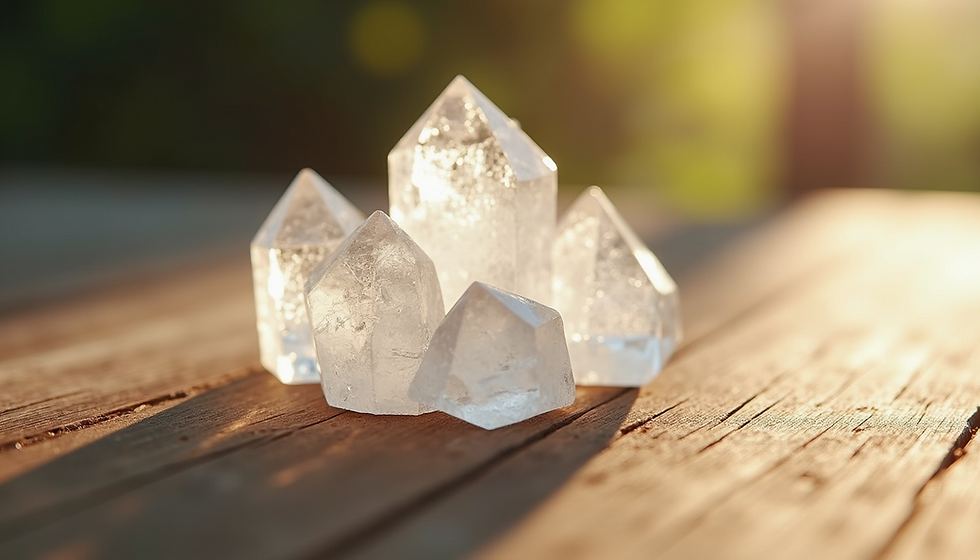Crystals vs. Gemstones: What to Know
- Dragonfly Crystal Store

- Oct 16
- 3 min read
When exploring the world of natural minerals, you may often hear the terms crystals and gemstones used interchangeably. However, these two categories have distinct characteristics and uses that make them unique. Whether you are a collector, a jewelry enthusiast, or someone interested in the metaphysical properties of minerals, understanding the differences between crystals and gemstones can enhance your appreciation and knowledge.

Crystals Versus Gemstones: Understanding the Basics
At the most basic level, crystals are solid materials whose atoms are arranged in an orderly repeating pattern extending in all three spatial dimensions. This structure gives crystals their unique shapes and physical properties. Crystals can form naturally or be grown artificially in labs.
Gemstones, on the other hand, are minerals that have been cut and polished to be used in jewelry or decoration. While many gemstones are crystals, not all crystals qualify as gemstones. Gemstones are valued for their beauty, rarity, and durability.
For example, amethyst is a purple variety of quartz crystal that is often cut into gemstones for rings and necklaces. Meanwhile, raw quartz crystals may be used for healing or decorative purposes without any cutting or polishing.
Understanding this distinction helps when choosing minerals for different purposes, whether for aesthetic appeal or metaphysical use.

What is the Difference Between a Gemstone and a Crystal?
The main difference lies in processing and use. Crystals are often found in their natural form, with visible geometric shapes and rough edges. They are appreciated for their natural beauty and energy. Gemstones, however, undergo cutting, shaping, and polishing to enhance their appearance and make them suitable for adornment.
Here are some key points to consider:
Formation: Both crystals and gemstones form naturally, but gemstones are selected for their clarity, color, and hardness.
Appearance: Crystals usually have a raw, natural look. Gemstones are refined and polished.
Purpose: Crystals are often used in healing, meditation, and decoration. Gemstones are primarily used in jewelry.
Value: Gemstones generally have higher market value due to the labor involved in cutting and polishing.
For example, a raw emerald crystal looks very different from a faceted emerald gemstone set in a ring. The gemstone’s cut enhances its brilliance and color, making it more desirable for jewelry.

How to Identify Crystals and Gemstones
Identifying whether a mineral is a crystal or a gemstone involves examining several factors:
Shape and Structure
Crystals often have well-defined geometric shapes such as hexagons or cubes. Gemstones may lose these natural shapes after cutting.
Surface Texture
Crystals have rough or uneven surfaces, while gemstones are smooth and shiny due to polishing.
Color and Clarity
Gemstones are selected for vibrant colors and minimal inclusions. Crystals may have cloudy or uneven coloration.
Hardness
Gemstones are usually harder and more durable, making them suitable for daily wear.
Use Context
If the mineral is set in jewelry, it is likely a gemstone. If it is used for display or healing, it may be a crystal.
For those interested in learning more about the properties and uses of crystals and gemstones, visiting a resource like the crystals and gemstones library can provide valuable insights.
Practical Tips for Buying and Caring for Crystals and Gemstones
Whether you are purchasing crystals for spiritual purposes or gemstones for jewelry, here are some practical tips:
Research the Mineral: Understand the specific properties and care requirements of the crystal or gemstone you want.
Buy from Reputable Sellers: Ensure authenticity by purchasing from trusted sources.
Handle with Care: Some crystals are fragile and can chip easily. Gemstones, while durable, can still be damaged by harsh chemicals or impacts.
Clean Properly: Use gentle cleaning methods. Avoid ultrasonic cleaners for delicate stones.
Store Separately: Keep crystals and gemstones in separate compartments to prevent scratching.
For example, selenite crystals are soft and can dissolve in water, so they should never be soaked. Diamonds, a popular gemstone, are extremely hard but can still be damaged by sharp blows.
The Unique Appeal of Crystals and Gemstones
Both crystals and gemstones have unique appeals that attract different types of enthusiasts:
Crystals: Loved for their natural beauty and metaphysical properties. Many people use crystals for meditation, energy healing, and home decor.
Gemstones: Valued for their brilliance, color, and use in fine jewelry. They symbolize status, love, and personal milestones.
Understanding these differences allows you to choose the right mineral for your needs, whether you want to enhance your spiritual practice or find the perfect piece of jewelry.
Exploring the world of crystals and gemstones opens up a fascinating journey into nature’s artistry and the science behind these beautiful minerals. With the right knowledge, you can appreciate their unique qualities and make informed choices.







Comments